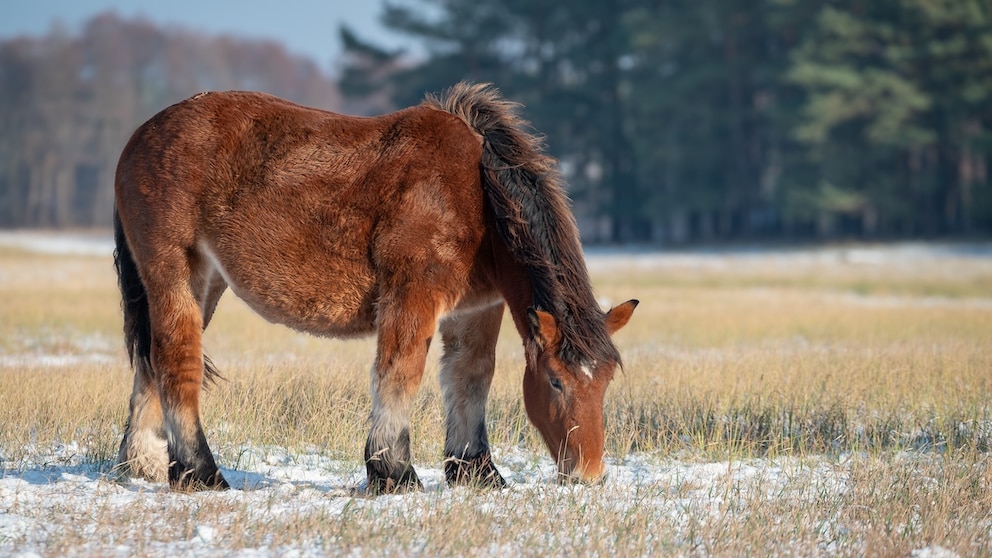March 12, 2025, 9:43 am | Read time: 4 minutes
Horses change their coat depending on the season — a thick winter coat protects them from the cold, while a shorter coat keeps them cool in summer. But what happens when the coat doesn’t change? In some cases, there is a serious disease behind it: Pituitary Pars Intermedia Dysfunction (PPID), better known as Equine Cushing’s Syndrome.
If a horse does not lose its winter coat, PPID, also known as Equine Cushing’s Disease, could be the cause. This hormonal disorder mainly affects older horses and, in addition to coat changes, leads to other health problems, such as muscle loss and laminitis. Early diagnosis and treatment are, therefore, crucial in order to maintain the animal’s quality of life.
PPID — Hormonal Disorder With Far-Reaching Consequences
PPID is a disease of the pituitary gland in which benign tumors lead to an excess of some hormones. “The tumors cause excessive secretion of certain hormones, which can cause a variety of symptoms,” explains Dr. Yatta Boakari of the Texas A&M College of Veterinary Medicine & Biomedical Sciences in a press release.
The effects of this disorder are varied and not always immediately obvious. Many different hormones can be affected by the disorder, including cortisol, dopamine, and insulin. In addition to the increased release of ACTH, which regulates adrenal cortical function, various peptides are also released in increased quantities.
The reason why Cushing’s disease occurs in horses is also not yet fully understood. It is estimated that PPID mainly occurs in older horses — around 15 percent of horses over the age of 15 are affected.1 “Although the disease is more common in older animals, it should not automatically be ruled out when a horse is younger,” emphasizes Boakari.
Symptoms Are More Than Just a Lack of Shedding
A characteristic sign of PPID is an unusually long, curly coat that does not fall out completely. However, not every affected horse shows this symptom. “It’s very important not to rule out PPID just because the horse doesn’t have a long coat,” warns Dr. Sophia Marchio. “There are many other symptoms that are far more dangerous to the horse’s well-being.”
The possible signs of PPID at a glance:
- Delayed or absent shedding
- Excessive coat growth (long, curly coat)
- Muscle loss
- Laminitis (inflammation of the hoof skin, also known as laminitis)
- Insulin resistance
- Chronic skin infections
- Weak immune system
- Tiredness and loss of performance
- Increased drinking and urination behavior
- Reproductive disorders
- Fat redistribution (e.g., pendulous belly or fat pads around the eyes)
“Exactly why different horses develop different symptoms is not yet fully understood,” continues Boakari. “It is therefore important to look at a horse’s entire medical history in order to make an informed diagnosis.”
The excess hormones caused by Cushing’s disease can have serious consequences: The normal daily rhythm of cortisol production is disrupted, which weakens the immune system. This increases the susceptibility to infections and laminitis, an often very painful inflammation of the hoof corium, which must then also be treated. The growing tumor can also affect brain structures and cause symptoms such as blindness.
Diagnosis and Treatment
Diagnosis is usually based on blood tests, in which the ACTH level is measured. But beware: a possible diagnosis should not be ruled out if the ACTH level in the blood is low at a particular time of year. Instead, further tests should be carried out. “In the early stages, a single determination is often not enough,” explains Marchio. “That’s why we also use stimulation or suppression tests.”
PPID cannot be cured, but it is very treatable. The most important measure is lifelong drug therapy with pergolide, a dopamine agonist. This medication compensates for the dopamine deficit and helps to control the symptoms. In addition, regular veterinary checks and adapted feeding and care are essential.

Zoonoses Feline zoonoses: Cats can transmit these diseases to humans

Inflammation of the gastric mucosa Causes and treatment for dogs vomiting on an empty stomach

Diagnosis, Treatment Cats and Dogs Can Also Develop a Pollen Allergy — These Are the Symptoms
Equine Cushing’s Syndrome Should Be Detected Early
Starting treatment early can significantly slow down the progression of the disease. “Patients with PPID have the best chances if the disease is detected early,” emphasizes Marchio. “That way, the symptoms can be managed effectively, and the horse’s quality of life can be improved.”
Even if it ultimately turns out that the symptoms are not caused by PPID, veterinary clarification is important. “Many of the typical symptoms are problematic in themselves, especially laminitis, which can lead to permanent lameness,” warns Boakari. “Therefore, any change in a horse’s health should be taken seriously.”

